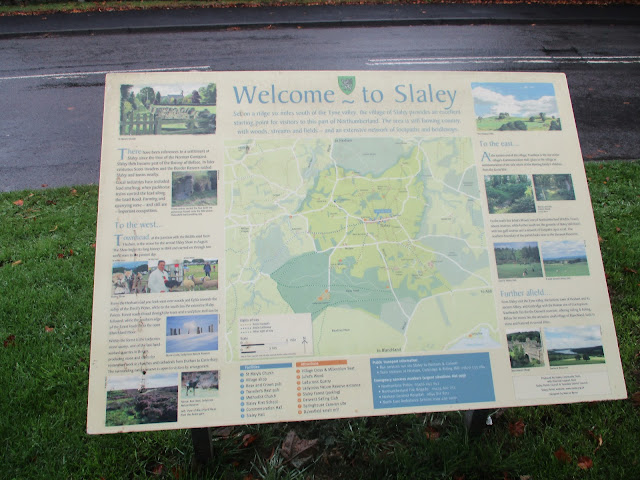Slaef- lead September 15th
S
Slaley is a long village on top of a hill in Northumberland. The namecomes from Old English slaef-leah meaning muddy place with a clearing.
The village church, St Mary's was built in the 19th century on the site of one built in 1312 on the site of an even earlier one.
Go west on the A69. At the roundabout for Corbridge follow the A68. At the next roundabout head for Riding Mill. Go through the village and turn left onto the hilly road to Slayley.
There is no car park, we left our cars near the church.
The walk is covered by OS OL 43 Hadrian's Wall.
Not a winning car park. Damp morning too.Slaley church. St Mary the Virgin.
There is a porch by the church gate with benches. Useful for booting up and donning waterproofs. The forecast was for rain all day, not heavy but long lasting drizzle.
Leaving the cars we headed west through the village, crossed the B6306 and walked along tracks to Dukesfield. (mile 2). The gate to the footpath at the farm is hidden but we crossed a field and joined the track down to the river.
Once a lead mining area. The arches took ore to the smelting house.
(There is a short black dotted line on the map at this point which is the route we took rather than the route we planned)
From the arches we followed the stream (Devil's Water), emerging into a single field (mile 3). A few exotic birds were pecking away.
Hairy legged rooster, one of several.
We found the entrance to the footpath taking us through woodland with evidence of the damage storm Arwen did . Reaching the junction at mile 4 we took the forestry track which was a little muddy to say the least. At one point we made use of several tree stumps for a Herbie, sharing apple pies, cheese scones, ginger biscuits, cookies and almond slices. It climbed steadily until it reached a well surfaced road where we turned left, walked downhill and turned right into the Spring House caravan park.
Spring House caravan site.














No comments:
Post a Comment